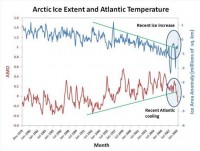By Richard James
Recent satellite observations from the Arctic indicate that spring ice melting is beginning at a lower rate than normal this year. According to the National Snow and Ice Data Center, the area of ice-covered ocean has decreased only about 750,000 km2 from its peak value at the end of February, compared to a normal decline of 1.1 million km2 by late April. If this trend continues, the annual ice melt in 2009 may be less than in recent years, and the late summer Arctic ice extent may rebound from its well-publicized downtrend.
The possibility of renewed ice growth in the Arctic is consistent with a recent dramatic trend towards cooler sea surface temperatures in the Atlantic Ocean. As discussed by StormX recently, Atlantic surface temperatures have declined significantly from their peak values of the mid-2000s, and consequently the 2009 Atlantic hurricane season is likely to be less active than recent years. The sudden downward trend in Atlantic surface temperatures is reflected by the Atlantic Multidecadal Oscillation (AMO) index, which has recently dropped to its lowest value since the mid-1990s.

See larger image here.
A comparison of the AMO index and the Arctic sea ice extent reveals that the well-known decline in Arctic sea ice area since the 1980s occurred concurrently with a marked rising trend in Atlantic surface temperatures. However, the recent Atlantic cooling has abruptly ended the warming trend. As the Atlantic has cooled in the past few years, the Arctic ice extent has ceased to fall, and there are suggestions that the ice extent may be starting to rebound. These changes highlight the importance of natural cyclical variability in the ocean-atmosphere system, and may also portend new global trends associated with reduced solar activity.
Read more here.
Icecap Note: Agree the Atlantic Multidecadal Oscillation and to a lesser degree the Pacific Decadal Oscillation control the amount of arctic ice as their warm modes mputs more warm water into the arctic, and their cold modes less warm water. The cooling of the Pacific has been dramtic in the last two years and now the Atlantic has at least temporarily cooled below the normal. That may help explain why the ice now is the highest in the JAXA AMSR-E data set since 2002 as of this date in their data set as shown below and enlarged here.





